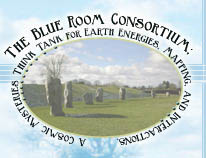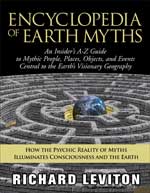

Books and Free Excerpts |
HOLLOW HILLS . Experiential doorways into the Earth's visionary geography and its 100+ different features, light temples, and residences of the gods.
|

Buy this book here:
Irish lore says many of the old hills and mounds in the countryside are hollow in the sense that they accommodate otherworldly fairy palaces, even the residences of the gods, known as the Tuatha de Danann. TheHollow Hill is somehow a portal through to where the fairies or gods are living. Such residences are not visible to ordinary sight, Irish lore says, but they are to those with second sight (clairvoyance) as they are situated in the Otherworld (another dimension). Once the Tuatha de Danann, Ireland's original gods, lived above ground and ruled Ireland bnevolently for 3,000 years, legend says; then they retreated into the Hollow Hills, known as the sidhe (pronounced shay) and reduced their influence on human affairs. Each of the major Tuatha got their own sidhe: Midir the Proud lived at Bri Leith; the Dagda (the Tuatha chief) or his son Aengus Og at Bruigh na Boinne; Una lived at Knockshegowna; Lir's palace was called SidheFionnachaidh; Ogma's was Sidhe Airceltrai; Lugh's was Sidhe Rodrubai. Another nuance has it that the sidhes mark the places where the Tuatha de Dannan left the Earth and disappeared into the underground, or Otherworld. On occasion (and Irish myth is rich in this) a Tuatha would suddenly appear out of the sidhe to intervene in human affairs, play enchanting music, or dally with people. Possibly out of respect for this possibility, traditionally Irish farmers avoided using the sidhe (or the landscape spot marking one such as a grass-rich rounded hill) and even the paths to it for cattle grazing or agriculture. Sometimes the gods or the fairies (the two, confusingly, got blurred together over the centuries, probably due to lack of human contact with and experience of them) were referred to as "people of the sidhe." Similarly, the sidhes (the physically visible aspects, like a hillfort, barrow, tumulus, or hillock) were often called fairy mounds. The well-known banshee is actually written bean-sidhe, meaning "woman of the sidhe." Originally it meant any woman who livedin the Hollow Hills, but later it came to more specifically refer to a death harbinger, an otherworldly spirit who announced by shrieking the imminent death of a human. Similarly, though using different terms, Tibetan traditions of "sacred geography" record how specific locations in the Tibetan landscape, such as a cliff, cave, land around a monastery, are the dwelling places of sublime deities. The Tibetans do not say Hollow Hills, but the extra-dimensionality is implied. Caves, rocks, land formations, and other geological features act as Hollow Hills. In one cave, after meditation, a psychic Buddhist practitioner (travelling Tibet in the 1850s) was able to see "infinite numbers" of the male and female Glorious Realm Protectors. At another location, those of pure vision (clairvoyance) could see the Palace of the Great Glorious Heruka (a wrathful protector being). A pair of high rocks, are the residences of the Lion-Faced Demon Protectors, Great Terrifier (a Realm Protector), the male spiritual warrior Vajra Light and the female spiritual warrior Powerful Woman of Lanka. Explanation : The terms Hollow Hills or sidhe are clues to the Earth's vast visionary geography and the openings into this realm through physical landscape features such as hills, caves, mounds, rockfaces, or human-made structures. The Earth's visionary geography consists of at least 95 different types of portals, doorways, or openings into the planet's subtle landscape. These different types have multiple copies, so that, for example, a Hollow Hill, sidhe, or landscape portal to the Rich Fisher King of Celtic lore is through any of 144 Grail Castles accessed through sacred or holy sites around the Earth. In all, there are many thousands of gateways into the Otherworld each accessed through a physical site. Thus Hollow Hill or sidhe can refer accurately to any of these 95 features. Often the sidhe or Hollow Hill leading to a Tuatha is already hallowed and culturally recognized as such, or at least it will carry an aura of numinosity. Places known as a god's sidhe or King Arthur's Hollow Hill, or even the fairy mounds, are functional passageways from our physical realm to their numinous one and as the Tibetan visionary cited above said, those of "pure vision", or the Celtic lore calls "second sight," may enter and visit with the gods and spirits. Hindu sacred geographic lore calls such places tirthas, or spiritual fords, where one can safely cross the "river" between physical and subtle realms. The ancient Druids used the term nemeton (from the Latin nemus meaning "Heaven") to indicate a sacred center, sanctuary, or enclosure, such as a grove or woodland clearing, as a place of spiritual exchange between the terrestrial and celestial worlds. Similarly the Romans spoke of a locus consecratus, "consecrated place." The Maori of New Zealand use the term wahi tapu, which literally means "sacred place," but whose wider connotations mean "windows to the past." Such places provide genealogical links to the Maori ancestors, original stories of creation, and events that define individual tribes within their landscapes. Such a portal site is hollow in the sense that to psychic perception, the inner aspect (varieties of light temples or celestial residences) seems to be inside the outer, physical one, rendering the latter a hollow quality. Or the inner aspect can be seen as overlapping, enveloping the physical, or even much larger than it. Irish lore says Fionn mac Cumhaill, the great hero of Ireland and leader of the Fianna (actually one of the 15 King Arthurs in Earth history) lives at the Sidhe of Almu, now called Hill of Allen, in County Kildare. Almu ("All-White") is an Irish goddess, but the whiteness also referred to Fionn's royal citadel on the hill. As mentioned, the British King Arthur lived at South Cadbury Castle, later called a Hollow Hill. In both cases, you may access King Arthur as the Solar Logos and his retinue in Ursa Major through either of these geomantic sites. The blurring of the Tuatha de Dannan in their sidhe with the fairies in their mounds if confusing and inaccurate. While both have their legitimate places of entry through the physical landscape, they are not the same order of beings. Fairies are as the legends say, small, angel-like beings who tend the plant kingdom, while the Tuatha are sages and adepts of the Great White Brotherhood. See also : Dreamtime, Fairyland Doors, Fairy Queen, Fionn mac Cumhaill, Fisher King, Grail Castle, Holy Mountain, Hurqalya, King Arthur, Tep Zepi, Tuatha de Danann Buy this book here: |
Newsletter (Back Issues) | Articles | Primers | About Blue Room | Projects and Research | Workshops and Field Trips | Trainings and Consultations
About the Ofanim | About the Founder-Director | Information for Investors | Links | Contact the Consortium
 Encyclopedia of Earth Myths. An Insider's A-Z Guide to Mythic People, Places, Objects, and Events Central to the Earth's Visionary Geography ( Charlottesville, VA: Hampton Roads Publishing, November 2005).
Encyclopedia of Earth Myths. An Insider's A-Z Guide to Mythic People, Places, Objects, and Events Central to the Earth's Visionary Geography ( Charlottesville, VA: Hampton Roads Publishing, November 2005).